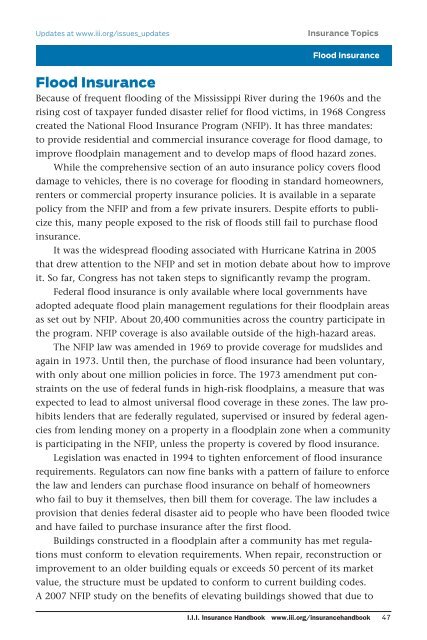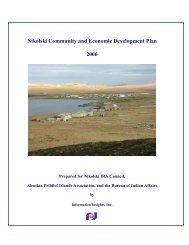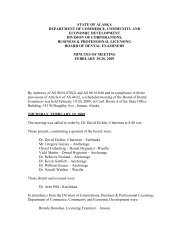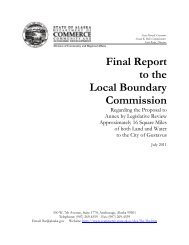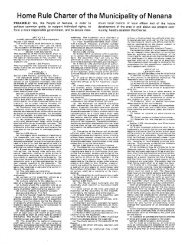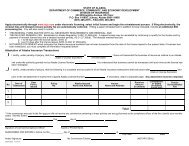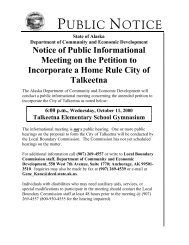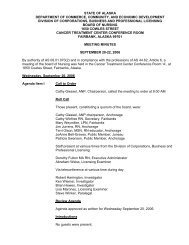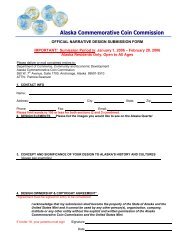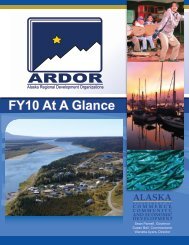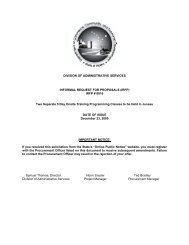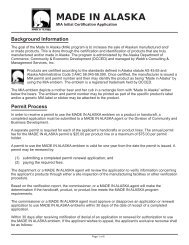Insurance Handbook - Alaska Department of Community and ...
Insurance Handbook - Alaska Department of Community and ...
Insurance Handbook - Alaska Department of Community and ...
Create successful ePaper yourself
Turn your PDF publications into a flip-book with our unique Google optimized e-Paper software.
Updates at www.iii.org/issues_updates <strong>Insurance</strong> Topics<br />
Flood Auto <strong>Insurance</strong><br />
Flood <strong>Insurance</strong><br />
Because <strong>of</strong> frequent flooding <strong>of</strong> the Mississippi River during the 1960s <strong>and</strong> the<br />
rising cost <strong>of</strong> taxpayer funded disaster relief for flood victims, in 1968 Congress<br />
created the National Flood <strong>Insurance</strong> Program (NFIP). It has three m<strong>and</strong>ates:<br />
to provide residential <strong>and</strong> commercial insurance coverage for flood damage, to<br />
improve floodplain management <strong>and</strong> to develop maps <strong>of</strong> flood hazard zones.<br />
While the comprehensive section <strong>of</strong> an auto insurance policy covers flood<br />
damage to vehicles, there is no coverage for flooding in st<strong>and</strong>ard homeowners,<br />
renters or commercial property insurance policies. It is available in a separate<br />
policy from the NFIP <strong>and</strong> from a few private insurers. Despite efforts to publicize<br />
this, many people exposed to the risk <strong>of</strong> floods still fail to purchase flood<br />
insurance.<br />
It was the widespread flooding associated with Hurricane Katrina in 2005<br />
that drew attention to the NFIP <strong>and</strong> set in motion debate about how to improve<br />
it. So far, Congress has not taken steps to significantly revamp the program.<br />
Federal flood insurance is only available where local governments have<br />
adopted adequate flood plain management regulations for their floodplain areas<br />
as set out by NFIP. About 20,400 communities across the country participate in<br />
the program. NFIP coverage is also available outside <strong>of</strong> the high-hazard areas.<br />
The NFIP law was amended in 1969 to provide coverage for mudslides <strong>and</strong><br />
again in 1973. Until then, the purchase <strong>of</strong> flood insurance had been voluntary,<br />
with only about one million policies in force. The 1973 amendment put constraints<br />
on the use <strong>of</strong> federal funds in high-risk floodplains, a measure that was<br />
expected to lead to almost universal flood coverage in these zones. The law prohibits<br />
lenders that are federally regulated, supervised or insured by federal agencies<br />
from lending money on a property in a floodplain zone when a community<br />
is participating in the NFIP, unless the property is covered by flood insurance.<br />
Legislation was enacted in 1994 to tighten enforcement <strong>of</strong> flood insurance<br />
requirements. Regulators can now fine banks with a pattern <strong>of</strong> failure to enforce<br />
the law <strong>and</strong> lenders can purchase flood insurance on behalf <strong>of</strong> homeowners<br />
who fail to buy it themselves, then bill them for coverage. The law includes a<br />
provision that denies federal disaster aid to people who have been flooded twice<br />
<strong>and</strong> have failed to purchase insurance after the first flood.<br />
Buildings constructed in a floodplain after a community has met regulations<br />
must conform to elevation requirements. When repair, reconstruction or<br />
improvement to an older building equals or exceeds 50 percent <strong>of</strong> its market<br />
value, the structure must be updated to conform to current building codes.<br />
A 2007 NFIP study on the benefits <strong>of</strong> elevating buildings showed that due to<br />
I.I.I. <strong>Insurance</strong> <strong>H<strong>and</strong>book</strong> www.iii.org/insuranceh<strong>and</strong>book 47


